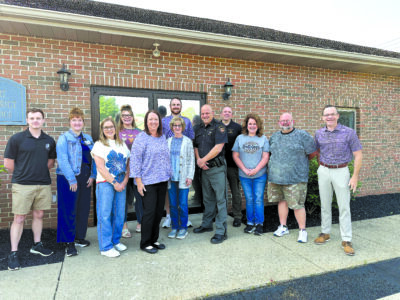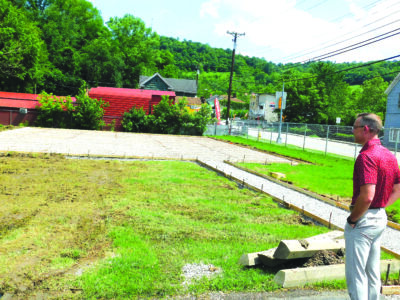Panel discusses economic future of oil and gas

Screenshot A panel of experts from the think tank Ohio River Valley Institute discussed the oil and gas industry and potential cracker plant at Dillies Bottom this week. Panelists expressed doubts about the economic future of the industry and its benefit to local residents.
ST. CLAIRSVILLE — An organization affiliated with environmentalist groups says it soon will produce studies suggesting that the oil and gas industry is on an economic decline and that a proposed ethane cracker plant should not become a reality in Eastern Ohio.
Panelists from the Ohio River Valley Institute, a think tank focused on “lasting job growth, clean energy, and more inclusive civic structures for northern Appalachia,” held a discussion Wednesday. Speakers at the economic forum included: Kathryn Hipple, professor of finance at Bard College and former financial analyst with the Institute for Energy Economics and Financial Analysis; John Hanger, energy consultant and former Pennsylvania Secretary of Environmental Protection; and Anne Keller, former Wood-Mackenzie petrochemical analyst and current industry consultant.
Sean O’Leary, senior researcher at the institute, said their topic was whether the “Shale Crescent” region of Ohio, West Virginia and Pennsylvania will realize the promise of economic renewal or if it’s on the verge of failing.
“We are a very new organization. We are a think-tank, and we are devoted to developing policy in the areas of economic development, energy, and also the democratization of election processes as well as policymaking and regulatory processes. In pursuit of that, we’re going to be hosting forums like this one.”
O’Leary said the group will be publishing three reports in the coming weeks. On Feb. 10 it will release an economic analysis of the effects of the fracking boom on 22 counties in Ohio, Pennsylvania and West Virginia that produce the majority of natural gas.
“It’s going to be a tale of places that have seen a massive runup in economic output that have not seen a comparable runup in measures of local economic prosperity,” he said.
He said another forthcoming report produced in collaboration with the Stockholm Environment Institute will look at the prospects and risks of the natural gas industry going forward. A third report will explore economic opportunities associated with reclaiming abandoned mines and natural gas wells.
They shared a portion of one report, stating that about a decade ago the natural gas boom promised hundreds of thousands of jobs in the region. While gas production volume exceeded expectations, local economic prosperity, personal income, jobs and population have not kept up.
The panel also discussed plastics manufacturing, noting that years ago there had been an expectation of multiple ethane cracker plants in the region, two hydrogenation plants and other assets. Currently, only one cracker plant in Beaver County, Pennsylvania, has been constructed. A final investment decision regarding another potential cracker plant in the Dillies Bottom area along Ohio 7 has been delayed indefinitely, with PTT Global Chemical America citing the COVID-19 pandemic as its primary reason for delay.
“We’re not sure at this point when or if we’re going to hear anymore about the PTT cracker,” O’Leary said. “Clearly the vision has been at the very least delayed, but the real question is, is it coming to an end? What has caused this intense delay?”
Hipple said the oil and gas industry is struggling.
“Companies have to make a decision about what demand will be like in a global market 10 years hence, and they’re making decisions, and let’s remember this is an industry in distress. The oil and gas industry globally has been in distress long before 2020 when the pandemic hit,” Hipple said. “You’ve got an industry in distress looking for salvation and hoping that the petrochemical buildout in Appalachia might be that lifeline, and the financials do not support that contention.
“I don’t believe (the cracker plant) will have the economic benefits that were initially promised to the state,” she said. “I think that is why other chemical companies and other oil companies have not rushed in. It’s a very large decision and it’s a boom/bust cycle.”
Hanger said he believed policymakers were too focused on a future tied to the industry.
“This is a story I’ve heard over 30 years of being involved in policy making,” he said. “That kind of motivated thinking often ignores stubborn facts.”
Keller said the demand for recycled plastic over virgin plastic would reduce an expected market for the cracker plant. They said the future would be in “clean tech.” Hanger mentioned investments in electric charging networks, offshore wind and solar generation.
“We have a new administration in Washington, and that administration, if it manages to enact what it has planned to do, we’ll have about $4 billion in funding over the next few years that it wants to invest in areas like energy efficiency,” O’Leary said.
Afterward, Mike Chadsey, director of public relations with the Ohio Oil and Gas Association that advocates for the industry, expressed doubts about the motivation behind the organization’s reports and their accuracy. He said the industry and the possible cracker plant are valuable to the area.
“One of the key lessons of this terrible pandemic is the value of available plastics. Plastics are the first line of defense against this raging pandemic. The price of resin is at an all-time high, which is why we are seeing onshoring of these types of facilities,” he said.
“Market studies show there is sufficient natural gas resources and sufficient workforce in the region for both our project to succeed in addition to the Shell project. These are good-paying, long-term jobs for folks right here in the valley,” he said. “Our members have invested over $86 billion in the last 10 years and are employing over 200,000 hard-working Ohioans and have donated hundreds of thousands of dollars to charitable causes.”
Dan Williamson, Columbus-based spokesman for PTTGCA, said the final investment decision had been likely before the COVID-19 pandemic stalled the process.
“If not for the pandemic, this project would be under construction right now,” he said. “PTT America is having very substantive conversations with reputable companies that are very interested in partnering with this project. The proof will be in the pudding when the project is announced.
“There’s a lot of activity,” he said, adding the company has made a considerable investment and that work such as purchasing and demolishing homes on the site continues. “There’s a lot of optimism about it. … We’ve had $200 million invested in this project. There’s continued investment.
“There are market studies that say this is extremely viable,” he said.
The link to sign up to view the upcoming reports is bit.ly/ORVIreports.




